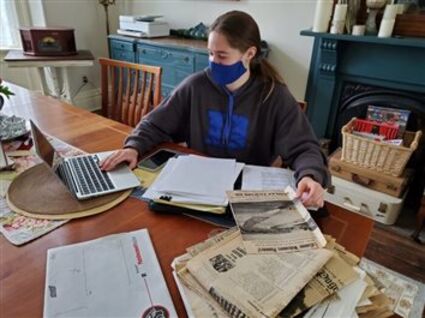Teen uses QR codes to shed light on town’s past
June 9, 2021

CRAMMING FOR A HISTORY PROJECT – La Conner High junior Rachel Cram has been reviewing multiple sources to develop an anecdotal history of downtown buildings since January. Among those sources are articles written by her great-grandfather, Puget Sound Mail publisher Pat O’Leary. Cram is scheduled to present her project to the Town Planning Commission on June 15. – Photo by Bill Reynolds
Local history will be shared well into the future thanks to a La Conner student’s research.
Rachel Cram, a La Conner high junior, is scripting audio recordings that with the press of a finger on a smartphone will provide anecdotal details about some of the town’s more historic downtown buildings.
Cram will present her project, which places optical sign labels on buildings, at the June 15 Town Planning Commission meeting. Each QR code contains building specific historical information.
Town Planner Michael Davolio has said the QR codes would be considered commemorative plaque signs and not require formal approval if they are smaller than three square feet in size.
Even so, Cram has agreed to apprise commissioners of her work, in part because it includes information not always found in prior histories of La Conner.
Much of her source material has been gleaned from stories written decades ago by Cram’s great-grandfather, Pat O’Leary, longtime publisher of the Puget Sound Mail, a historic La Conner weekly newspaper.
Sifting through those articles, Cram has been able to connect past owners and uses with the present status of historic buildings.
“I’m always getting more connections,” she told the Weekly News. “And now that I have more connections, I know I need to do even more research.”
One of Cram’s key supporters is Mayor Ramon Hayes.
“He told me this will probably be an ongoing project,” she said, “because I’ll find myself always doing more updating and editing.”
Her work is the brainchild of family friend Lori Gould, who since moving here from Chicago has fully embraced local history and has often expressed interest in the backstories of buildings that grace the town’s historic preservation district.

Cram knew she could shed light on the topic, mindful that her grandmother, Sally O’Leary Cram, has maintained an extensive file of back issues of the Puget Sound Mail.
“I thought the perfect person for this would be my grandma Sally,” Cram said. “She has tons of stuff. She has definitely helped me a lot.”
So, too, has her mom, Lynette Cram, a La Conner school board member who has offered recollections of her own youth growing up here. Among her favorite memories are visits to the former La Conner Drug Store building on First Street, now home to La Conner Sips.
“I remember we’d go there to shop for Mother’s Day,” Lynette Cram recalled, “and we’d ask Fred Martin, the pharmacist, how much something cost.
He was so nice. We’d hold out the change we had in our hands and he’d ask how much we had. When we told him, he’d say: ‘that’s just enough.’”
Daughter Rachel has shown an uncanny knack for boiling similar oral accounts and lengthy articles into brief audio descriptions – just long enough to tell an interesting story without delaying a pedestrian audience making its way up and down First Street.
She has also made use of period maps and photographs of old La Conner in crafting her fast-paced scripts.
Through her research, Cram has been able to track changes over time in the local economy.

“There were so many different kinds of businesses here,” she said.
Buildings that now house upscale boutiques and restaurants were once home to thrift stores, machine shops, dry goods and grocery outlets, shoemaking and repairing, and a multi-use barber shop.
“The barber did everything,” Cram said. “It seemed like everything always happened at the barber shop.”
For instance, the late Thurman “Smitty” Schmittou, who had been stationed with the U.S. Army at Fort Whitman on nearby Goat Island, used part of his building as a barber shop. Remaining space was devoted to storage and mending of commercial fish nets.
Cram discovered there was a time when Wiggin-Felton customers could go downtown to buy a 16-ounce container of peanut butter for 37 cents. She read reports of the Puget Sound Mail building having sustained damages from a rockslide. She learned that Ruth Pennington operated the Fidalgo School of Allied Arts, drawing students each summer from the University of Washington to the large red building where the Ginger Grater is now located.
A key theme of downtown La Conner has been its resilience, Cram noted. For a century and a half, it has survived both the fickle nature of the business cycle and potentially devastating structure fires, she said.
“A lot of the original buildings were damaged by fire at one time or another,” Cram said.
A top student and three-sport athlete at La Conner High, Cram manages to devote a couple hours each week to her history project. Having begun in January, she had hoped to complete work in time for the Tulip Festival. But the research has had a way of mushrooming, each lead branching in several new directions.
Target date for completion is now sometime this summer.
She is not in a big hurry to finish what has become a true labor of love.
“It’s been a lot of fun,” said Cram, who hopes her work will earn academic credit in video production from La Conner High teacher Ryan Hiller. “It’s something I’m pretty passionate about.”




Reader Comments(0)